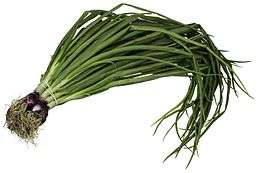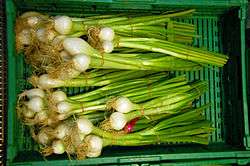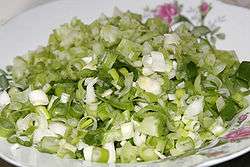Scallion

Scallion, Green Onion, Spring Onion and Salad Onion are English names (with many other regional names throughout the world) for various Allium species. All of the Allium have hollow green leaves (like the common onion), but these are used while they lack a fully developed root bulb. Used as a vegetable, they are eaten either raw or cooked. Scallions have a milder taste than most onions.
Etymology
The words scallion and shallot are related and can be traced back to the Greek ασκολόνιον ('askolonion') as described by the Greek writer Theophrastus. This name, in turn, seems to originate from the name of the ancient Canaan city of Ashkelon. The plant itself apparently came from farther east of Europe.[1]
Types

Species and cultivars which may be called "scallions" include:
- A. cepa
- "White Lisbon"
- "White Lisbon Winter Hardy"—an extra-hardy variety for overwintering
- Calçot
- A. cepa var. cepa—Most of the cultivars grown in the West primarily as scallions belong to this variety.[2] However, the "scallions" from A. cepa var. cepa (common onion) is from a young plant, harvested before bulbs form, or sometimes when slight bulbing has occurred.
- A. cepa var. aggregatum, formerly A. ascalonicum), common name shallot. Shallots are also referred to as eschalot.
- A. chinense
- A. fistulosum, the Welsh onion, does not form bulbs even when mature, and is grown in the West almost exclusively as a scallion or salad onion, although in Asia this species is of primary importance and used both fresh and in cooking.[3]
- A. ×proliferum, sometimes used as scallion[4]
- A. ×wakegi, the Wakegi onion, sometimes used as scallions[4]
Uses


Spring onions may be cooked or used raw as a part of salads, salsas, or Asian recipes. Diced scallions are used in soup, noodle and seafood dishes, as well as sandwiches, curries or as part of a stir fry. In many Eastern sauces, the bottom half-centimetre (quarter-inch) of scallions roots is commonly removed before use.
In Mexico and the Southwest United States, cebollitas are scallions that are sprinkled with salt and grilled whole and used with cheese and rice. Topped with lime juice, they typically serve as a traditional accompaniment to asado dishes.[5][6]
In Catalan cuisine, calçot is a variety of onion traditionally eaten in a calçotada (plural: calçotades). A popular gastronomic event of the same name is held between the end of winter and early spring, where calçots are grilled, dipped in salvitxada or romesco sauce, and consumed in massive quantities.[7][8]
In Japan, scallions are cultivated in two separate ways. In Western Japan, "leaf" green scallions are typically consumed, where the green portion is consumed. In Eastern Japan, "root" green scallions are popular. The scallions are partially buried, so a portion of the stalk is kept underground. As a result, a significant part of the stalk remains white in color, and has been cultivated to be very thick. The green portion of these "root" scallions are discarded, and the thick white portions of the scallion are consumed. In Japanese cuisine, scallions are used in abundance, as an accompaniment to tofu, noodle dishes, hot pots, and stir fries.
In Vietnam, Welsh onion is important to prepare dưa hành (fermented onions) which is served for Tết, the Vietnamese New Year. A kind of sauce, mỡ hành (Welsh onion fried in oil), is used in dishes such as cơm tấm, bánh ít, cà tím nướng, and others. Welsh onion is the main ingredient in the dish cháo hành, which is a rice porridge dish to treat the common cold.
In India it is eaten as an appetizer (raw) with main meals. In north India Coriander, Mint and Onion Chutney is made using scallions (raw).
In southern Philippines, it is ground in a mortar along with some ginger and chili pepper to make a native condiment called wet palapa, which can be used to spice up dishes, or topped in fried or sun dried food. It could also be used to make the dry version of palapa, which is stir fried fresh coconut shavings and wet palapa.
During the Passover meal (Seder), Persian Jews lightly and playfully strike family members with scallions when the Hebrew word dayenu is read, symbolizing the whips endured by the Israelites under the ancient Egyptians.[9]
An oil, scallion oil is sometimes made from the green leaves. The leaves are chopped, lightly cooked, oil is added and then it is liquidised. The oil is then used as a garnish.
Regional and other names
Scallions have various other common names throughout the world. These names include spring onion, green onion, table onion, salad onion, onion stick, long onion, baby onion, precious onion, yard onion, gibbon, syboe, scally onion, or shallot. Scallion and its many names can also be mistakenly used for the young plants of the shallot (A. cepa var. aggregatum, formerly A. ascalonicum), harvested before bulbs form, or sometimes when slight bulbing has occurred.
- Albania: Known as qepë të njoma meaning "young/baby onions".
- Arabic: Known in the Arabic-speaking countries as بصل أخضر ("green onion").[10]
- Argentina: Known as cebolla de verdeo.
- Australia: The common names are "spring onions" and "shallots".[11]
- Belgium: In the Dutch speaking part it is known as "pijpajuin", which means "tubular onion".
- Bosnia and Herzegovina: Known as "mladi luk".
- Brazil: Known as cebolinha,[12] which is also the Portuguese word for chives. A more precise term is cebolinha-verde which refers specifically to A. fistulosum.[13]
- Canada: Known as "green onion".[14]
- Caribbean: Often referred to as "chives".
- China: The common name is cōng (葱); xiǎocōng (小葱) is another term for Scallion.[15]
- Colombia: Known as "cebolla larga".
- Costa Rica: Usually "cebollín".
- Denmark: Known as forårsløg when referring to undeveloped A. pena and pibeløg when referring to A. fistulosum.[16]
- Dominican Republic: Known as "cebollín".
- Ecuador: Known as "cebolla larga".
- England and some Commonwealth countries, including Singapore: The most common name is "spring onion".
- Estonia: Known as roheline sibul (literally "green onion")
- Finland: Known as kevätsipuli (literally "spring onion")
- Germany and Austria: Known as Frühlingszwiebel (among other names), which means "spring Onion".[17]
- Greece: Known as φρέσκο κρεμμυδάκι.[18]
- Hungary: Known as újhagyma (literally "new onion")
- Iceland: Known as vorlaukur (literally "spring onion").[19]
- India: May be referred to as "spring onion", and in Hindi-speaking areas as hara pyaz.
- Indonesia and Malaysia: Known as daun bawang (onion leaf). The same term is used for leeks (daun bawang perai). Chinese chives which can be mistaken for scallions are called daun kucai.[20]
- Israel: Known as batzal yaroq (בצל ירוק), which means green onion.
- Iran:[21] Known as پیازچه.
- Ireland and Northern Ireland: The term "scallions" is commonly used.[22]
- Italy: Known as cipolla d'inverno ("winter onion"),[23] cipollotto or cipolletta,[24] which means "little onion", "cipollotti freschi" (fresh little onions), or cipolla verde ("green onion").
- Japan: Known as negi (葱 / ねぎ).[25]
- Jamaica: Known as escallion; a Welsch onion
- Korea: Known as pa (파).[26]
- Kyrgyzstan: Known as көк пиаз, which literally translates to "blue onion".
- Latvia: Known as sīpolloki
- Lithuania: Known as laiškinis svogūnas in Lithuania, which means leafy onion.[27]
- Netherlands: Known as bosuitjes, which literally translates as "forest onions", or lenteuitjes, which translates as "spring onions".[28]
- New Zealand: The common name is "spring onion".[29]
- Norway: Known as vårløk (bokmål) or vårlauk (nynorsk)
- Peru: The common name is cebolla china which means "Chinese onion" in Spanish.[30]
- Philippines: Known as sibuyas na mura.[31] It is also called berdeng sibuyas.[32]
- Poland: Known as szczypior.
- Romania: Known as ceapă verde, which means "green onion".[33]
- Scotland: Known as "spring onion", and also in Scots as cibies[22] or sibies, from the French syboe.
- Serbia and Croatia: Known as mladi luk, which means "young onion".[34][35]
- Spain: Known as "Cebolleta". In the little city of Valls (Catalonia), there's a local traditional variety of sweety onion named Calçots.
- Sri Lanka: Known as loonu kola (ලූනු කොළ), which literally means "onion leaves". Or in Tamil as (வெங்காயத்தாள்)
- Sweden: Known as salladslök, meaning "salad onion", or vårlök, meaning "spring onion". (One source insists that vårlök is inedible, a misnomer brought about through confusion with the English name "spring onion".)[36]
- Turkey: Known as taze soğan, meaning "fresh onion".
- United States: Known as "scallion" or "green onion" except for the New Orleans area where it is known as shallot. The term "green onion" is also used in reference to immature specimens of the ordinary onion (Allium cepa) harvested in the spring.
- Wales: Known as "spring onion" or "gibbon" /ˈdʒɪbən/.[37] Also known in South Wales as sibwn (pronounced "shibun"),[38] which originates from the French ciboule.
See also
References
- ↑ Allium Crop Science: recent advances at Google Books, last retrieved 2007-03-31.
- ↑ Fritsch, R.M.; N. Friesen (2002). "Chapter 1: Evolution, Domestication, and Taxonomy". In H.D. Rabinowitch and L. Currah. Allium Crop Science: Recent Advances. Wallingford, UK: CABI Publishing. p. 20. ISBN 0-85199-510-1.
- ↑ Fritsch, R.M.; N. Friesen (2002). "Chapter 1: Evolution, Domestication, and Taxonomy". In H.D. Rabinowitch and L. Currah. Allium Crop Science: Recent Advances. Wallingford, UK: CABI Publishing. p. 18. ISBN 0-85199-510-1.
- 1 2 Brewster, James L. (1994). Onions and Other Vegetable Alliums (1st ed.). Wallingford, UK: CAB International. p. 15. ISBN 0-85198-753-2.
- ↑ Cebollitas, last retrieved 2012-09-01.
- ↑ At the Nation's Table: Chicagoat New York Times Archives, last retrieved 2012-09-01.
- ↑ Els "Calçots"
- ↑ Grilled Green Onions with Romesco, last retrieved 2012-09-01.
- ↑ "An Iranian Seder in Beverly Hills". The New York Times.
- ↑ "Learn about the Method of Cultivation of Green Onions" attarzaman.com (Arabic)
- ↑ "What are Spring Onions?" ( January 22, 2013) goodfood.au
- ↑ Cebolinha cresce na água (Portuguese)
- ↑ "Como plantar cebolinha verde" (Portuguese)
- ↑ "A microbiological survey of selected Alberta-grown fresh produce from farmers' markets in Alberta, Canada." (2009) Journal of Food Protection Vol.72 Nº2 pp.415-20
- ↑ 大葱知识介绍 (A description of green onions) (Chinese)
- ↑ "Pibeløg, Milda - Allium fistulosum" (Danish)
- ↑ J. Becker-Dillingen (1956)Handbuch des gesamten Gemüsebaues, einschliesslich der Küchenkräuter, 6th edition p.686, P. Parey, Berlin (German)
- ↑ WordReference.com
- ↑ Vorlaukurinn endalausi ("Scallion goodness") (Icelandic)
- ↑ Manfaat Daun Bawang untuk Kesehatan (Indonesian)
- ↑ Farsi-English dictionary
- 1 2 Breanne Findlay. Breanne Findlay (2012) The Celtic Diet: Let History Shape Your Future, p. 41, Trafford Publishing, ISBN 9781466963573
- ↑ Cipolla inverno - Allium fistulosum - Piante medicinali (Italian)
- ↑ Cipolla in Vocabolario – Treccani (Italian)
- ↑ 学名従う。 TropicosではA. × proliferum (Moench) Schrad. ex Willd (1809) としている
- ↑ 《우리가 정말 알아야 할 우리 음식 백가지》, (한복려) 현암사. 1998 (Korean)
- ↑ "About Scallions in Lithuanian"
- ↑ Veggipedia (Dutch)
- ↑ "Spring onions" Vegetable.co.nz
- ↑ "Aportes medicinales y nutritivos de la cebollita china o verdeo" (Spanish)
- ↑ Tagalog Translator Online
- ↑ MyMemory.translated.con
- ↑ "Ceapa verde contine unul din cei mai puternici antioxidanti din natura. Cum te sfatuiesc nutritionistii sa o consumi" (March 8, 2014) FoodStory.ro (Romanian)
- ↑ "Mladi luk čini čuda za naše zdravlje" (April 7, 2014) alo.rs (Serbian)
- ↑ Mladi luk predstavlja iznimnu nutritivnu (Croation)]
- ↑ "Vårlök och salladslök" (May 9, 2006) Matälskaren (Swedish)
- ↑ Gary Hunter, Terry Tinton, and Patrick Carey. Professional Chef – Level 3 – S/Nvq. Cengage Learning EMEA, 2008. ISBN 9781844805310
- ↑ MyMemory.translated.net
External links
| Wikimedia Commons has media related to Scallions. |
.jpg)